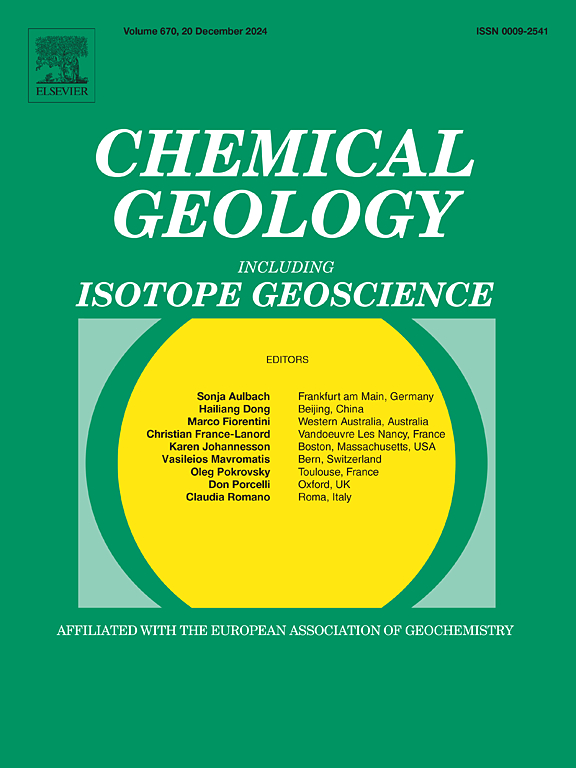南蛇绿岩Kızıldağ绿片岩变质作用下的铬铁矿组成变率及蚀变动力学
IF 3.6
2区 地球科学
Q1 GEOCHEMISTRY & GEOPHYSICS
引用次数: 0
摘要
本文研究了Kızıldağ蛇绿岩(t本文章由计算机程序翻译,如有差异,请以英文原文为准。

Compositional variability and alteration dynamics of chromitites under greenschist metamorphism in the Kızıldağ ophiolite, southern Türkiye
This study presents a complete alteration sequence in chromitites from the Kızıldağ ophiolite (southern Türkiye), documenting three distinct chromite types that record processes related to Neotethyan subduction. Chromitites exhibit predominantly lenticular forms and occasionally banded textures, embedded within mantle peridotites and the mantle-crust transition zone, specifically harzburgite and dunite. Our analysis categorizes chromite grains into three groups: fresh, altered, and porous. Fresh chromites are characterized by high contents of Cr2O3 ranging from 42.69 to 57.08 wt% and Al2O3 from 12.46 to 25.34 wt%. In contrast, altered chromites, typically located along fractures or at the edges of fresh grains, show significant variability in chemical composition, with Cr2O3 content between 43.34 and 63.94 wt% and Al2O3 between 2.91 and 14.84 wt%. Porous chromites, distinguished by their porous structure, present Cr2O3 contents from 44.58 to 52.66 wt% and Al2O3 from 3.00 to 8.38 wt%. Notably, altered and porous chromites demonstrate substantial enrichments in Fe and trace elements such as Mn, Ni, Zn, Co, and Ga, indicating a shift due to metamorphic processes. The observed high Cr# (0.68–0.93) and low Mg# (0.25–0.65) values in rims of the altered and porous chromite further illustrate the metamorphic influence on chromite, with greenschist-facies conditions indicated by the Cr–Al–Fe3+ diagram at temperatures below 450 °C. The alteration dynamics reflect a progression that initiates with the olivine matrix and advances through reactions involving fresh chromites. This progression results in mass loss, the formation of chlorite, and the porous structures. Our findings contribute to the understanding of metamorphic alteration processes in chromitites and provide a detailed account of the geochemical trends (such as Fe/Mg exchange and trace element enrichment) that reflect greenschist-facies metamorphism. The evidence of chlorite formation and the prevalence of porous textures highlight the influence of metamorphic fluids over serpentinization, offering a model for chromite alteration in supra-subduction zones. This research elucidates the metamorphic history of chromitites in the Kızıldağ ophiolite.
求助全文
通过发布文献求助,成功后即可免费获取论文全文。
去求助
来源期刊

Chemical Geology
地学-地球化学与地球物理
CiteScore
7.20
自引率
10.30%
发文量
374
审稿时长
3.6 months
期刊介绍:
Chemical Geology is an international journal that publishes original research papers on isotopic and elemental geochemistry, geochronology and cosmochemistry.
The Journal focuses on chemical processes in igneous, metamorphic, and sedimentary petrology, low- and high-temperature aqueous solutions, biogeochemistry, the environment and cosmochemistry.
Papers that are field, experimentally, or computationally based are appropriate if they are of broad international interest. The Journal generally does not publish papers that are primarily of regional or local interest, or which are primarily focused on remediation and applied geochemistry.
The Journal also welcomes innovative papers dealing with significant analytical advances that are of wide interest in the community and extend significantly beyond the scope of what would be included in the methods section of a standard research paper.
 求助内容:
求助内容: 应助结果提醒方式:
应助结果提醒方式:


